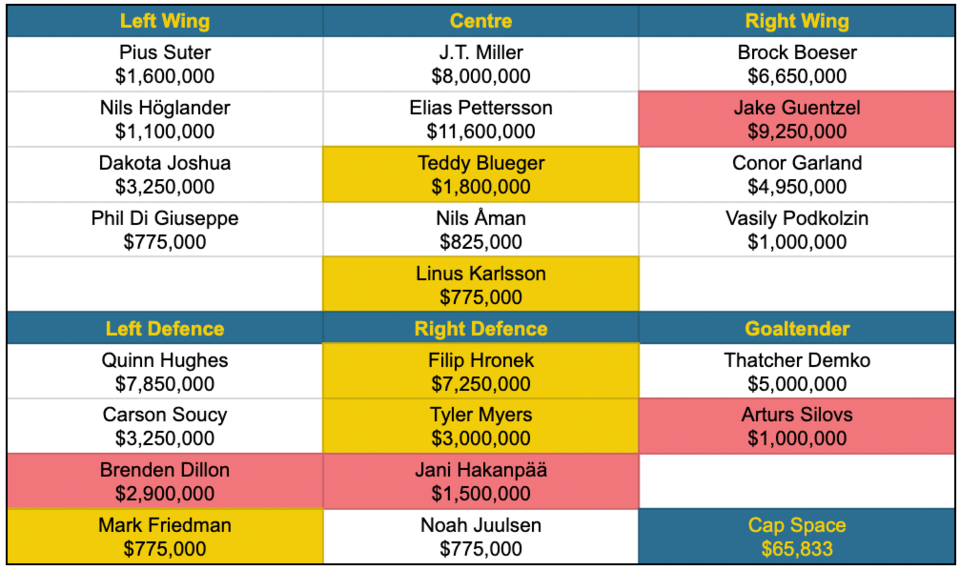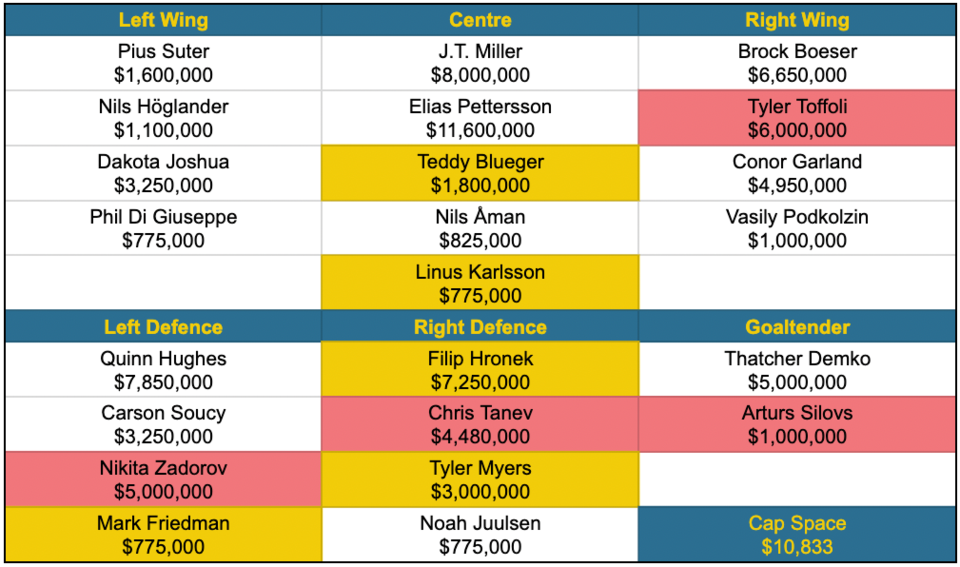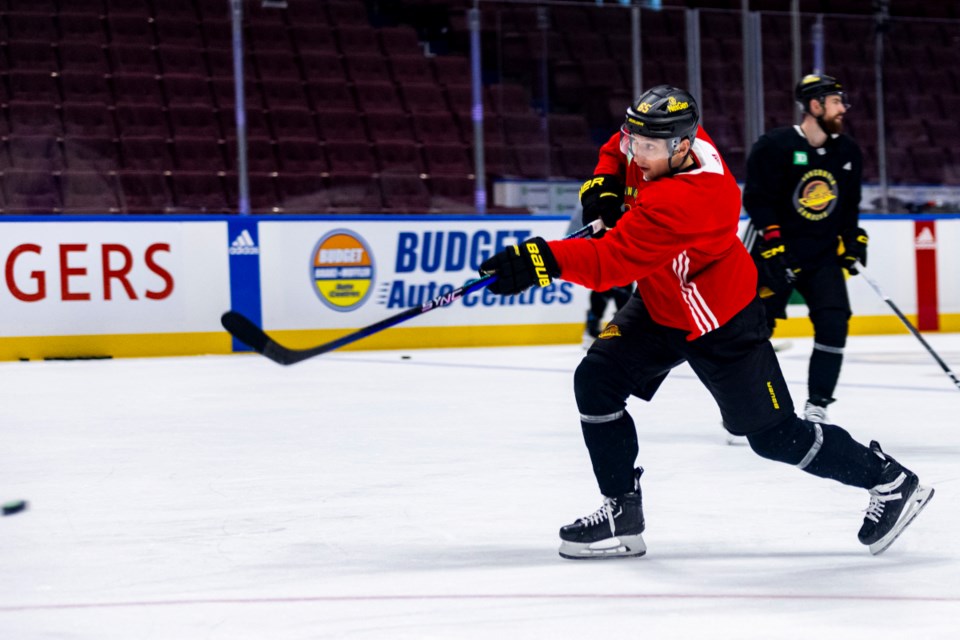After a frantic couple of days for the Â鶹´«Ã½Ó³»Canucks, Ilya Mikheyev is out, Dakota Joshua and Tyler Myers are in, and we know one thing for certain about next season: Elias Pettersson will have a new primary linemate.
Mikheyev was Pettersson's most frequent linemate at 5-on-5 this past season, which wasn't ideal. The snake-bitten winger struggled to produce down the stretch and didn't tally a single point in the playoffs, which wasn't much help to Pettersson as he battled through an injury.
With the fleet-footed Russian bound for the Chicago Blackhawks, Pettersson will be getting a new partner, likely via free agency. The cap space freed up by the Mikheyev trade, however, won't be much help in facilitating a new top-six winger, as most of it was immediately spent to re-sign Dakota Joshua.
The Canucks retained 15% of Mikheyev's salary in the trade, which works out to $712,500, which will count against the Canucks' salary cap for two more seasons. That means the Canucks cleared $4,037,500 from their cap. The Canucks then signed Joshua to a four-year contract with a $3.25 million cap hit, so the overall cap savings comes out to just $787,500 — approximately the cap hit of a player on a league-minimum contract.
Then the Canucks spent that money and a little more to re-sign Tyler Myers to a three-year deal with a $3 million cap hit.
What does this all mean for the Canucks' salary cap picture? How much cap space do they have going forward, what holes in the roster do they need to fill, and how might they allocate their cap space to fill those holes?
The Canucks have ~$15.5 million in cap space
Here's where the Canucks stand after the recent trade and signings, with players arranged into where they might fit in the lineup:

With 18 out of 23 players on the roster, the Canucks have $15,490,833 in cap space remaining.
Notably, this is with Tucker Poolman's $2.5 million cap hit already on LTIR. If the Canucks could somehow fit Poolman's cap hit on the roster to start the season, that would open up the possibility of throughout the season, which a team cannot do if they start the season using the cap relief from LTIR.
The biggest need for the Canucks is obvious. They need at least one top-six winger, though it would certainly be nice to find two. They do have wingers who can credibly fill the other top-six spot alongside J.T. Miller and Brock Boeser, as Pius Suter did during the playoffs, so the priority is a winger to play with Pettersson.
On defence, they need two more defencemen and, depending on how much they pay for a top-six winger, could only have the cap space available for two bottom-pairing defencemen.
The Canucks will also need to round out their roster with a backup goaltender and a 13th forward.
How can the Canucks divvy up their ~$18.5 million cap space between these needs? Let's run through some options.
Top-Six Winger: $6 million to $9.5 million
A big chunk of the Canucks' remaining cap space has to be devoted to finding Pettersson a running mate. The Canucks are most likely targeting Jake Guentzel () but there are other potential targets.
At the top end, you've got Sam Reinhart, who just scored 57 goals and won the Stanley Cup. He could be in line for a $10-11 million contract in free agency, so let's assume that's out of the Canucks' range.
Guentzel could get as much as $9-9.5 million per year on a seven-year deal, which is a lot but is doable for the Canucks and possibly their best option to significantly upgrade their lineup heading into next season.
At the lower end, there's Tyler Toffoli, who already has some familiarity and chemistry with the Canucks, and Jonathan Marchessault, who's coming off 42 goals for the Vegas Golden Knights and won a Conn Smythe just last year. Toffoli and Marchessault are likely to sign somewhere in the $6-7 million range but both are a little older than Guentzel.
The other free-agent options leave something to be desired. Paying in the $4-5 million range for a lesser winger could wind up leaving the Canucks with another Mikheyev situation on their hands. Oddly enough, paying a higher price is likely the less risky bet.
Top-Four Right-Shot Defenceman: $4 million to $6.5 million
The Canucks were pretty good defensively this past season with Myers playing the third-most minutes on the blue line but that doesn't mean they should be satisfied with Myers still in a top-four role heading into next season. If the Canucks want to push Myers down to the third pairing, however, that likely means no Guentzel, as they'll need the cap space.
There are a few options in the $5-6.5 million range, such as Matt Roy and Brett Pesce. That might prove too pricey for the Canucks but there are ways they could make it work.
A tier down in terms of cap hit in the $4-4.5 million range, there's Sean Walker, Alex Carrier, and Canucks fan favourite Chris Tanev. The Canucks are reportedly interested in Tanev but term might prove an issue as he's about to turn 35. As good as Tanev is, the younger Walker or Carrier might be better bets long-term.
Bottom-Pairing Defencemen: $775,000 to $5.5 million
Here's where things get finicky.
The Canucks could conceivably go cheap on their bottom pairing. There are some useful defencemen available in free agency who could be had for around $1-1.5 million per year, such as Jani Hakanpää, Derek Forbort, and Brendan Smith.
Then there's the next tier up, with a player like Brenden Dillon or Dmitry Kulikov, who will likely be in the $2.75-3.25 million range.
The Canucks could even go ultra cheap by using Noah Juulsen and/or Mark Friedman on the right side of the bottom pairing with their league-minimum $775,000 cap hits and calling up another defenceman with a league-minimum cap hit to serve as the eighth defenceman, like Guillaume Brisebois, Christian Wolanin, or Cole McWard.
Or the Canucks could spend big on Nikita Zadorov, paying him $5-5.5 million per year on a five-year deal.
Zadorov wouldn't be a typical third-pairing defenceman — he averaged 20+ minutes per game in the playoffs — but he feels like a bit of a luxury for the Canucks. It's a luxury the Canucks won't have in their budget if they spend big on Guentzel in free agency.
Backup Goaltender: $1 million to $2.5 million
It's an easy assumption that Arturs Silovs will be the Canucks' backup next season after his playoff performance but it's not a given. The restricted free agent will likely get a contract with a cap hit of around $1 million, so we'll call that the lower end of what the Canucks will spend on the position.
On the other hand, CHEK TV's Rick Dhaliwal is reporting that the Canucks are . If there are concerns about Thatcher Demko's health or playing Silovs 30 games next season, it would make sense for the Canucks to add some more goaltending depth.
That could mean re-signing Casey DeSmith, who will likely run around $1.5-1.8 million, or someone in the same range as DeSmith, such as Scott Wedgewood.
Other options include Kevin Lankinen, Anthony Stolarz, Alex Nedeljkovic, or Laurent Brossoit, but those four are likely to land in the $2-2.5 million range, or potentially even more with a weak free agent market for goaltenders. With cap space at a premium, it wouldn't make sense to spend too much on this position.
13th Forward: $775,000 to $870,000
Linus Karlsson's league-minimum contract gives him a good shot of winning the job as the Canucks' 13th forward but the Canucks have some other internal options, like Arshdeep Bains, Max Sasson, and Aatu Räty.
There's also the possibility of keeping all four of those players in the AHL to continue developing and signing a veteran free agent to sit in the press box as the 13th forward.
Either way, this position should cost the Canucks as little money as possible.
Two potential rosters for the Canucks
With all of the above in mind, here's a potential roster for the Canucks if they successfully woo Jake Guentzel in free agency. The players in red are as yet unsigned and cap hits are estimates.

This roster comes in $65,833 under the salary cap and requires some lesser spending on the Canucks' needs on defence.
Both Brenden Dillon and Jani Hakanpää bring size and physicality to replace what the Canucks would be losing in Zadorov at a cheaper price. The issue is, they don't bring the same wild card offence as Zadorov.
What about if the Canucks don't win the Guentzel sweepstakes? What would that look like?
Here's a potential lineup that sees the Canucks spend less on a top-six winger, freeing up cap space to upgrade on defence:

This roster sees the Canucks sign Tyler Toffoli for $6 million, leaving them close to $9.5 million available to spend on two defencemen. That would allow the Canucks to re-sign Nikita Zadorov at $5 million per year and add a top-four right-side defenceman like Chris Tanev, Sean Walker, or Alex Carrier at a hair under $4.5 million.
The Canucks could also sign a more expensive right-side defenceman like Matt Roy or Brett Pesce and sign a cheaper left-side defenceman like Brenden Dillon in this scenario.
This combination of contracts leaves the Canucks with just $10,833 in cap space.
There are pros and cons to both approaches and neither addresses the possibility of a more expensive backup goaltender. These are also just thought experiments and could be completely blown up by prices soaring in free agency. It's also an open question of how much of an improvement each of these rosters is over last season.
What these thought experiments illustrate, however, is that the Canucks won't be able to sign both Guentzel and Zadorov unless one or both sign for much less than the projections say they will. Heck, $5 million for Zadorov is already a discount from the $5.3 million on a five-year deal projected by AFP Analytics.
The Canucks can take a home-run swing for Guentzel but it'll mean limited funds available on defence. Likewise, the Canucks can spend big to improve the blue line but it'll mean a lesser winger on Pettersson's line.
It's a matter of what the Canucks want to prioritize.



